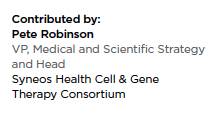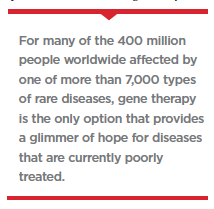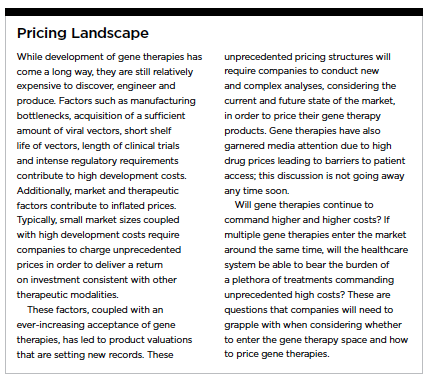Considerations and Challenges in an Evolving Market
 Two decades ago, as gene therapy was emerging as the next great frontier in modern medicine, the field was forced to recon with tragedy: the death of Jesse Gelsinger as a direct result of a gene therapy treatment he was given. For Jesse, the novel therapy showed promise of a chance at a new life — one free from ornithine transcarbamylase deficiency (OTCD), a genetic disease that had plagued him his entire life. Sadly, the treatment Jesse was given led to his death, shaking up the world of gene therapy.
Two decades ago, as gene therapy was emerging as the next great frontier in modern medicine, the field was forced to recon with tragedy: the death of Jesse Gelsinger as a direct result of a gene therapy treatment he was given. For Jesse, the novel therapy showed promise of a chance at a new life — one free from ornithine transcarbamylase deficiency (OTCD), a genetic disease that had plagued him his entire life. Sadly, the treatment Jesse was given led to his death, shaking up the world of gene therapy.
Despite the tragic results of Jesse’s treatment, exploration of gene therapy continued on for the same reason that Jesse entered his gene therapy trial. For many patients with debilitating or life-threatening rare genetic diseases, gene therapy is their only hope. Eighty percent of rare diseases are genetically based, meaning that they can be targeted by a gene therapy. For many of the 400 million people worldwide affected by one of more than 7,000 types of rare diseases, gene therapy is the only option that provides a glimmer of hope for diseases that are currently poorly treated.
 Gene therapy as a field has greatly advanced since Jesse received his treatment, with seven approved gene therapies available in the U.S. or EU market as of July 2020 and hundreds more in development. Concurrently, the lessons learned from Jesse’s death have led to increased and stricter regulations on gene therapy safety and efficacy.
Gene therapy as a field has greatly advanced since Jesse received his treatment, with seven approved gene therapies available in the U.S. or EU market as of July 2020 and hundreds more in development. Concurrently, the lessons learned from Jesse’s death have led to increased and stricter regulations on gene therapy safety and efficacy.
Current Market Challenges — From Development to Commercialization
First, our analysis indicates that gene therapy development is quickly expanding beyond ultra-rare conditions. Many indications under investigation are on the higher end of the rare disease scale (retinitis pigmentosa and AADC deficiency) and some are not rare diseases (WetAMD and familial/early onset Parkinson’s disease). Consider the fact that Parkinson’s disease is a primary target in CNS and wet AMD-related macular degeneration in ophthalmology, with many programs in clinic and advanced to Phase II. The prevalence of Parkinson’s disease in the United States has surpassed 1 million (according to the Parkinson’s Foundation), with wet AMD surpassing 200,000 (American Macular Degeneration Foundation) and is projected to increase significantly as the U.S. population continues to age.
Secondly, our analysis produced a surprising conclusion regarding the sheer concentration of development activity around certain indications in the gene therapy space. Looking again at Parkinson’s disease, Syneos Health has found at least eight programs conducted by different developers, with half of those programs advanced to Phase II. The statistics are not much different in ophthalmology, where more than 50% of the 50 development programs (discovery and in-clinic) that we were able to account for were associated with wAMD, achromatopsia, and retinitis. In hematology, sickle cell disease and hemophilia follow the same pattern.
Given these two observations, we have highlighted several other pressing concerns that biopharma companies in or planning to enter the gene therapy space should be considering:
Market structure and development:
Market structure and development is not so much an issue of awareness or attitudinal change as we think about it today, but rather a question of whether the current structure of the market can support introduction of a particular product.
For instance, is it reasonable to think that the Parkinson’s disease market will have evolved to a point where in five years it could easily absorb the introduction of two or three new gene therapies (in addition to, potentially, a number of disease modifying therapeutics leveraging more traditional modalities)? Let us say that all of these gene therapies have some degree of safety risk, and most, if not all, must be administered directly into an exact spot into the brain using some type of MRI-guided surgical procedure intravenously under supervision of the healthcare provider (HCP). Consider the fact that neurological surgeons are only doing 2,000 to 3,000 deep brain stimulation procedures annually. Even if they are targeting a subset of those patients with a relevant genetic mutation, what is the feasibility of having the capacity to administer treatment to the patient population? This example suggests that companies must start thinking differently about market development, particularly the need to expand outreach and educational activities beyond usual stakeholders.
Competition and product differentiation:
It is straightforward to envision the value proposition of a new gene therapy to treat hemophilia relative to factor concentrates that the patient/caregiver administers either episodically or prophylactically for a lifetime. However, how will we distinguish between two or more gene therapy products that could be available for use, either in the clinical or post-launch settings? Have we envisioned a future market scenario and, if not, then how will gene therapy companies compete in the future or for clinical trial enrollment today? What will be the new basis of competition, and what types of capabilities will gene therapy companies need to develop in order to be successful post launch? It is a given that the scope of competition in the future needs to be addressed early in development through clinical trial design, but for gene therapies it may need to be extended well beyond the label to the entire value chain, which could have a profound impact on organizational design, roles and responsibilities.
Patient communication:
Clearly, drug companies have been in the business of direct-to-patient communication for quite some time and gotten quite skillful at driving product awareness through traditional media and, most recently, social media, with the goal of getting the patient to visit the HCP while very thoughtfully keeping the HCP as the intermediary. How could this straightforward and highly regulated communication process differ if a curative gene therapy launched in Parkinson’s disease? What if this therapy addressed many patients with Parkinson’s disease, but not all of them? What if the existing market infrastructure could not support the avalanche of patient demand? These questions certainly raise the issue of what the future roles and responsibilities will be of HCPs and biotechnology companies in communicating with patients, especially large groups of patients, around important issues related to market expectations, behaviors and experiences.
 Gene therapies are here, and more seem to be coming in waves. They can be game changing — offering a potential cure to so many patients suffering from devastating rare and terminal illnesses. However, launch of these products will not be without challenges. The more successful these products are at treating or curing a disease, the more they will challenge our capability and capacity as a society of ensuring that as many patients as possible have access as quickly as possible. As more and more gene therapies become available, developers will be increasingly challenged to differentiate or clearly articulate the value proposition their product delivers to a patient versus another, and this choice may not always be made based on safety or efficacy. Both challenges should cause developers to pause to evaluate or re-evaluate the potential complexities of the markets they intend to participate in, the needs of customers and other stakeholders, as well as corporate capabilities, roles and responsibilities, and structure.
Gene therapies are here, and more seem to be coming in waves. They can be game changing — offering a potential cure to so many patients suffering from devastating rare and terminal illnesses. However, launch of these products will not be without challenges. The more successful these products are at treating or curing a disease, the more they will challenge our capability and capacity as a society of ensuring that as many patients as possible have access as quickly as possible. As more and more gene therapies become available, developers will be increasingly challenged to differentiate or clearly articulate the value proposition their product delivers to a patient versus another, and this choice may not always be made based on safety or efficacy. Both challenges should cause developers to pause to evaluate or re-evaluate the potential complexities of the markets they intend to participate in, the needs of customers and other stakeholders, as well as corporate capabilities, roles and responsibilities, and structure.
In Conclusion…
Read further analysis on this topic from the Syneos Health Cell and Gene Consortium at https://www.syneoshealth.com/insights-hub/gene-therapy-considerations-and-challenges-evolving-2020-market.
Learn more about gene therapies and the role they play in addressing rare diseases, by joining Syneos Health for a Rare Disease Day Webinar Series that will bring together leading minds in the rare disease space and patients for thought-provoking presentations and candid discussion about the present and future state of clinical research in rare disease. Register and find more information about the event at syneoshealth.com/events. (PV)
~~~~~~~~~~~~~~~~~~~~~~~~~
Pricing Landscape
While development of gene therapies has come a long way, they are still relatively expensive to discover, engineer and produce. Factors such as manufacturing bottlenecks, acquisition of a sufficient amount of viral vectors, short shelf life of vectors, length of clinical trials and intense regulatory requirements contribute to high development costs. Additionally, market and therapeutic factors contribute to inflated prices. Typically, small market sizes coupled with high development costs require companies to charge unprecedented prices in order to deliver a return on investment consistent with other therapeutic modalities.
These factors, coupled with an ever-increasing acceptance of gene therapies, has led to product valuations that are setting new records. These unprecedented pricing structures will require companies to conduct new and complex analyses, considering the current and future state of the market, in order to price their gene therapy products. Gene therapies have also garnered media attention due to high drug prices leading to barriers to patient access; this discussion is not going away any time soon.
Will gene therapies continue to command higher and higher costs? If multiple gene therapies enter the market around the same time, will the healthcare system be able to bear the burden of a plethora of treatments commanding unprecedented high costs? These are questions that companies will need to grapple with when considering whether to enter the gene therapy space and how to price gene therapies.
Syneos Health Cell & Gene Therapy Consortium is a group of cross-functional experts who have deep experience navigating the challenges unique to Cell and Gene Therapy Trials across clinical development and commercialization.
For more information, visit
syneoshealth.com.
















